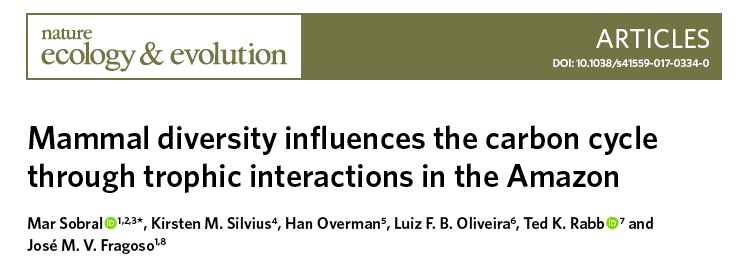File: Download
Year of Publication: 2017
Author(s): Mar Sobral, Kirsten M. Silvius, Han Overman, Luiz F.B. Oliveira, Ted K. Rabb, Jośe M.V. Fragoso
Journal: Nature Ecology and Evolution
Abstract:
Biodiversity affects many ecosystem functions and services, including carbon cycling and retention. While it is known that the efficiency of carbon capture and biomass production by ecological communities increases with species diversity, the role of vertebrate animals in the carbon cycle remains undocumented. Here, we use an extensive dataset collected in a high-diversity Amazonian system to parse out the relationship between animal and plant species richness, feeding interactions, tree biomass and carbon concentrations in soil. Mammal and tree species richness is positively related to tree biomass and carbon concentration in soil—and the relationship is mediated by organic remains produced by vertebrate feeding events. Our research advances knowledge of the links between biodiversity and carbon cycling and storage, supporting the view that whole community complexity—including vertebrate richness and trophic interactions—drives ecosystem function in tropical systems. Securing animal and plant diversity while protecting landscape integrity will contribute to soil nutrient content and carbon retention in the biosphere.
The views and opinions expressed through the MAHB Website are those of the contributing authors and do not necessarily reflect an official position of the MAHB. The MAHB aims to share a range of perspectives and welcomes the discussions that they prompt.
